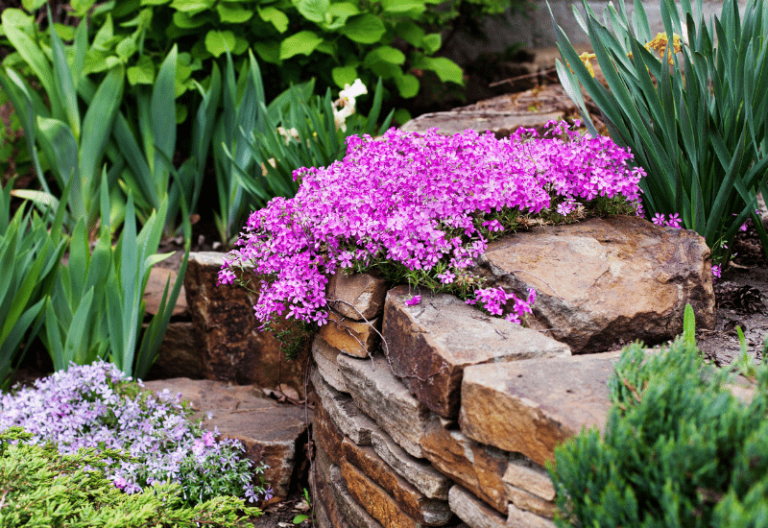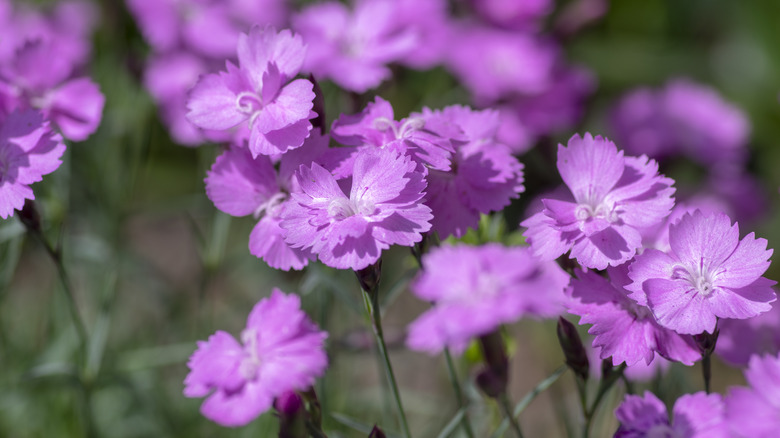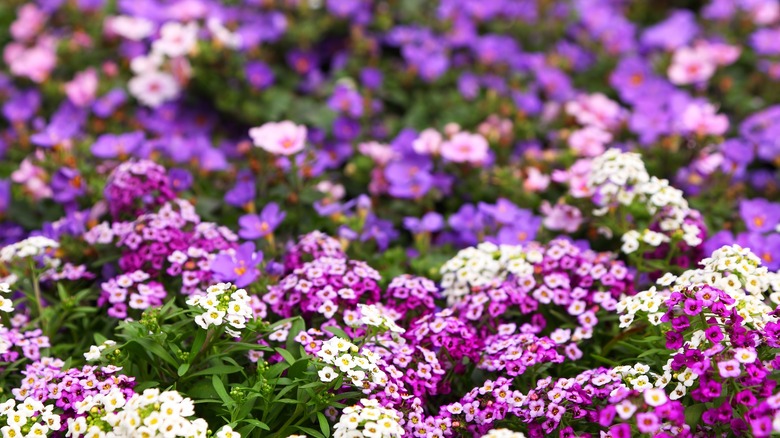#12 Best Purple Flower Ground Cover Perennials to Brighten Your Landscape
Purple flowering ground cover perennials are a great way to add vibrant color to your garden or landscape With their low-growing habit, these plants spread to form a lush carpet of blooms and foliage Whether you’re looking to fill in bare patches between stepping stones, cascade down a slope, or provide a pop of color under trees, there are many beautiful options to choose from.
In this article, we’ll explore 12 of the best purple flowering ground cover perennials and how to care for them. From hardy creeping phlox to delicate violets, read on to find your perfect match!
Why Choose Purple Flowering Ground Covers?
Before diving into the specific plant options, let’s look at why purple flowering ground covers are so popular:
-
Vibrant color – The purple palette ranges from pale lavenders to deep burgundies, adding bold yet refreshing hues to your garden These blooms stand out against greens or greys
-
Long bloom time – Many purple perennials flower for months, from spring through fall. Some even offer winter interest.
-
Low maintenance – Ground covers tend to need less care once established. Their spreading nature crowds out weeds too.
-
Erosion control – Low carpeting plants prevent soil erosion on banks and slopes. Their roots stabilize the soil.
-
Weed suppression – A thick mat of ground cover blocks light to suppress weed growth. No more pulling!
-
Drought tolerance – Many spreading perennials withstand droughts once established. Less watering needed.
With those benefits in mind, let’s get to the list! Here are 12 of the best purple flowering ground cover perennials for every garden:
1. Creeping Phlox
Creeping phlox (Phlox subulata) is one of the most popular choices, thanks to its easy care nature and carpet of spring blooms. Flower colors include purples, pinks, whites, and bicolors. The needle-like evergreen foliage takes on a reddish hue in winter.
This native plant thrives in full sun and well-drained soil. It spreads readily by underground stems, reaching 8 inches tall and 2 feet wide. The fragrant flowers attract pollinators too. Just remove spent blooms and prune lightly to encourage dense growth.
Hardiness: Zones 3-8
Light Needs: Full Sun to Partial Shade
Mature Size: Height 8 inches, Spread 2 feet
2. Violet
Charming violets offer a delicate touch of purple and periwinkle blue blooms from early spring into summer. While the common blue violet (Viola sororia) spreads aggressively, many other species and cultivars form tidy clumps.
All violets thrive in partial to full shade and moist, rich soil. The heart-shaped leaves may be evergreen or semi-evergreen depending on climate. These sweet gems reseed freely and make lovely companions to spring bulbs and other woodland plants.
Hardiness: Varies by species, typically Zones 4-9
Light Needs: Shady
Mature Size: Height 3-6 inches, Spread Varies
3. Periwinkle
With its glossy green foliage and cheerful periwinkle blooms, lesser periwinkle (Vinca minor) is a gardener favorite. One of the few ground covers that tolerates full sun or shade, this European native spreads vigorously by underground runners.
Left alone, periwinkle can cover large areas and exclude other plants. But controlled in optimal growing conditions, it makes a lush evergreen carpet under trees or mixed borders. Just watch for its invasive tendencies.
Hardiness: Zones 4-8
Light Needs: Full sun to Full shade
Mature Size: Height 4-6 inches, Spread Indefinitely
4. Dead Nettle
Despite their common name, ornamental dead nettles like spotted dead nettle (Lamium maculatum) offer long-lasting color. Their purple hooded blooms appear in spring above variegated silvery-green leaves.
These shade-loving perennials spread aggressively via stolons and rhizomes. While they make excellent ground covers, especially under trees, keep them contained to prevent rampant spread. Good drainage is essential too.
Hardiness: Zones 3-10
Light Needs: Shade
Mature Size: Height 8-10 inches, Spread 2-3 feet
5. Bugleweed
For stunning spring color, few plants rival bugleweed (Ajuga reptans). Its short upright spikes of purple, blue, or white blooms stand out against the fresh green leaves. Though the blooms are fleeting, the foliage forms a lush carpet.
Bugleweed thrives in moist, well-drained soil and partial to full shade. A fast spreader, it’s ideal for mass plantings but requires some control. Be cautious in hot humid climates as it’s prone to fungal issues.
Hardiness: Zones 3-9
Light Needs: Partial to Full Shade
Mature Size: Height 4-8 inches, Spread 1-2 feet
6. Creeping Thyme
With tiny leaves and a spreading habit, creeping thyme (Thymus praecox) makes an excellent lawn alternative. Flowers burst forth in pinks, purples, and whites in early summer with a delightful fragrance too.
This rugged little plant needs full sun and lean, well-drained soil to thrive. It turns woody with age, so shear occasionally to encourage new growth. Creeping thyme can handle some foot traffic but performs best when left undisturbed.
Hardiness: Zones 4-8
Light Needs: Full Sun
Mature Size: Height 2-4 inches, Spread 10-18 inches
7. Candytuft
Though often seen in white, candytuft (Iberis sempervirens) also comes in rich rosy-purples and reds. The flat-topped blooms completely smother the fine evergreen foliage in spring for a vibrant floral display.
For best flowering, plant candytuft in full sun and average to poor, well-drained soil. Avoid wet conditions. This hardy perennial spreads via rooting stems. Shear off spent blooms to encourage reblooming.
Hardiness: Zones 3-9
Light Needs: Full Sun
Mature Size: Height 6-12 inches, Spread 1-2 feet
8. Dwarf Plumbago
Valued for its electric blue flowers, dwarf plumbago (Ceratostigma plumbaginoides) also offers a purple-flowered cultivar called ‘Monroe White’. Pale violet-blue blooms with a white eye appear in late summer and fall.
The foliage is attractive too, with small green leaves that turn bronzy-red in fall. This clump-forming semi-evergreen spreads slowly via rooting stems. Grow it in full sun or light shade and well-drained soil.
Hardiness: Zones 5-9
Light Needs: Sun to Part Shade
Mature Size: Height 6-12 inches, Spread 1-2 feet
9. Obedient Plant
Bringing late summer color, obedient plant (Physostegia virginiana) produces abundant spikes of tubular blooms in shades of pink, purple, and white. It spreads quickly to form large clumps.
Though named for its blooms that stay in place when bent, this perennial can be anything but obedient! Keep it contained and site carefully, as it can be a thug. But its vivid blooms light up the shade garden.
Hardiness: Zones 3-9
Light Needs: Part to Full Shade
Mature Size: Height 2-4 feet, Spread 2-4 feet
10. Wild Geranium
Easy to grow and subtle in appearance, wild geranium (Geranium maculatum) brings charming purple-pink blooms in spring above deeply cut foliage that turns red in fall.
Preferring dappled or partial shade and moist rich soil, wild geranium spreads slowly via rhizomes to form loose colonies. The blooms attract pollinators while the foliage has a pleasant spicy aroma when crushed.
Hardiness: Zones 3-8
Light Needs: Part Shade to Shade
Mature Size: Height 1-2 feet, Spread 1-2 feet
11. Cyclamen
Grown for its small butterflies of blooms, hardy cyclamen offers garden color from late summer into fall when little else blooms. Flower colors include white, pink, red, and purple. Foliage is elegantly silver marked.
Cyclamen thrive in dappled sunlight and well-drained soil. Tubers sprout in early spring. Established plantings bloom for months and self-seed for naturalizing. Mulch in winter for protection in cold climates.
Hardiness: Varies by species, Zones 5-9
Light Needs: Shade to Part Shade
Mature Size: Height 3-6 inches, Spread 6-12 inches
12. Ice Plant
Ice plant (Delosperma) provides a bold punch of color with electrifying purple-pink daisy blooms smothering succulent foliage. It thrives in hot, sunny spots with lean soil and good drainage.
This drought-tolerant succulent spreads via runners and self-seeding. Give ice plant plenty of room, as it expands rapidly in ideal growing conditions. Just watch for reversion to plain green types.
Hardiness: Varies by cultivar, typically Zones 5-10
Light Needs: Full Sun
Mature Size: Height 2-4 inches, Spread 2-3 feet
Caring for Purple Flowering Ground Covers
To help your new purple perennials thrive, keep these tips in mind:
-
Plant in spring or fall, allowing time for roots to establish before heat or cold.
-
Water regularly the first season, especially during droughts. Then water only during prolonged dry spells.
-
Apply a balanced organic fertilizer in early spring to support growth.
-
Mulch around plants to conserve moisture and reduce weeds. Replenish mulch annually.
-
Cut back spent blooms and old growth as needed to encourage fresh growth and flowering.
-
Watch for aggressive spreaders like vinca and lamium. Keep contained within beds or edging.
With the right growing conditions and minimal care, these vivid bloomers will carpet your garden or landscape with months of purple beauty. Try combining colors and leaf textures for stellar visual interest too. Now go brighten up those bare spots!

‘Sherwood Purple’ woodland phlox

Woodland phlox refers to two different species. They are both spring bloomers that spread new roots gently from their main clump. The Sherwood Purple cultivar is a Phlox stolonifera and is shorter than its cousin Phlox divaricata (the Clouds of Perfume variety mentioned below), growing to a height of 6 to 8 inches, and its flowers also have more rounded petals. It blooms in partial to full shade and increases in size slightly each year. Divide it when you divide your other perennials in the fall by digging it up and gently separating the root clump.

Dianthus flowers, also known as pinks, are an easy-to-grow cottage garden favorite. The blooms last for weeks and if deadheaded will form new buds. There are a few different types of dianthus with different growth habits. The Dianthus deltoides variety works best as a ground cover: the spiky blue-green leaves and flower stems spread out from the central root system. The range of colors is vast and new hybrids appear every year. Some wonderful purple cultivars include Delilah, Everlast Violet Blue, and Paint the Town Magenta. Plant in full sun for the best flowers.

Sweet alyssum is one of those annuals that often reseeds and becomes perennial in the right circumstances. Its a charming ground cover and even though the stems and leaves look delicate, they form a dense mat and prevent weeds from poking through. Plant sweet alyssum in a spot where it can spread in your garden, creating a colorful edge or filling in bare spots. The tiny flowers come in a wide range of colors from white to dark purple and many bi-colors. Some of the best purple alyssum varieties include Violet Queen, Violet Knight, and Royal Carpet.
‘Purple Beauty’ creeping phlox

Creeping phlox (Phlox sublata) is also known as moss phlox and is covered in small five petal flowers from mid-spring through early summer. The Purple Beauty cultivar will spread fast, but it wont overtake other plants. It has vibrant flowers of orchid pink with a small violet eye. Creeping phlox blooms best in partial to full sun, and does well planted on the edge of flower beds, spilling over rock walls, or in sloped garden beds. Best of all, its actually an evergreen plant to keep color in your yard all year long.
8 Stunning Ground Cover Plants – Create A Carpet Of Color & Texture (even in difficult places!)
FAQ
What is the ground cover with purple flowers?
Lamium maculatum ‘Purple Dragon’ – Forms dense spikes of deep purple flowers over attractive crisp silver leaves with rich green edges.
What is the purple invasive ground cover?
What is the invasive purple ground cover? That’s most likely ajuga, commonly known as carpetweed or bugleweed. There are varieties with green leaves that turn purple in the fall and other cultivars with purple leaves all season long.
What is the purple flower creeping plant?
Phlox subulata ‘Purple Beauty’ (Creeping Phlox) is a top choice for an easy-to-grow, ground covering addition to a rock garden, perennial border, bulb garden, or slope.
What is the purple flowering plant that comes back every year?
Catmint. Plants don’t get any tougher than catmint. It thrives in hot, dry climates and blooms all season long. It forms a low, rounded mound of silvery-blue foliage with spikes of perennial purple flowers.
Are purple ground cover plants creeping or spreading?
Perennial ground cover plants are low-growing creeping or spreading plants. As cold-hardy plants, purple ground cover perennials come back year after year, covering the ground with green foliage and beautiful lilac, violet, blue, or lavender blooms. Here are some of the best ground cover perennials with purple flowers.
Are purple flowers a good ground cover?
Ground cover with purple flowers is a beautiful and versatile way to add color to your garden. The low-growing, mat-forming creeping plants are mostly evergreen and perennial spreading plants. Depending on your garden, you can plant these purple flowering ground cover plants under shade or full sun.
What is a purple ground cover plant with variegated leaves?
If you are looking for a purple ground cover plant with variegated leaves, choose the Vinca minor ‘Variegata.’ This cultivar has white and green leaves and violet-blue flowers growing in a low mat of leathery foliage. Perennial ground cover plants are low-growing creeping or spreading plants.
Which ground cover plants have purple blooms?
Here are 15 wonderful ground cover plants with purple blooms to consider: 1. Periwinkle (Vinca minor) Periwinkle is a gracious and evergreen ground cover plant with lavender colored blooms. With their iconic whirling petals with flat tips, they look very much like little fans.
Do purple flowered cover plants grow together?
Purple flowered cover plants are mostly mat-like as they spread along the ground covering every section; however, some can grow a little taller. Most of these plants can grow together as they share the growing conditions, so don’t worry if you have a large landscape; you can add these flowers.
How to grow purple flowers in a garden?
The most critical thing is to provide the right growing conditions, and these plants will easily thrive. It is possible to add these flowers to various gardens – rock gardens, hedges, slopes, etc. Ground cover with purple flowers are some of the best colorful plants to add to any garden.
